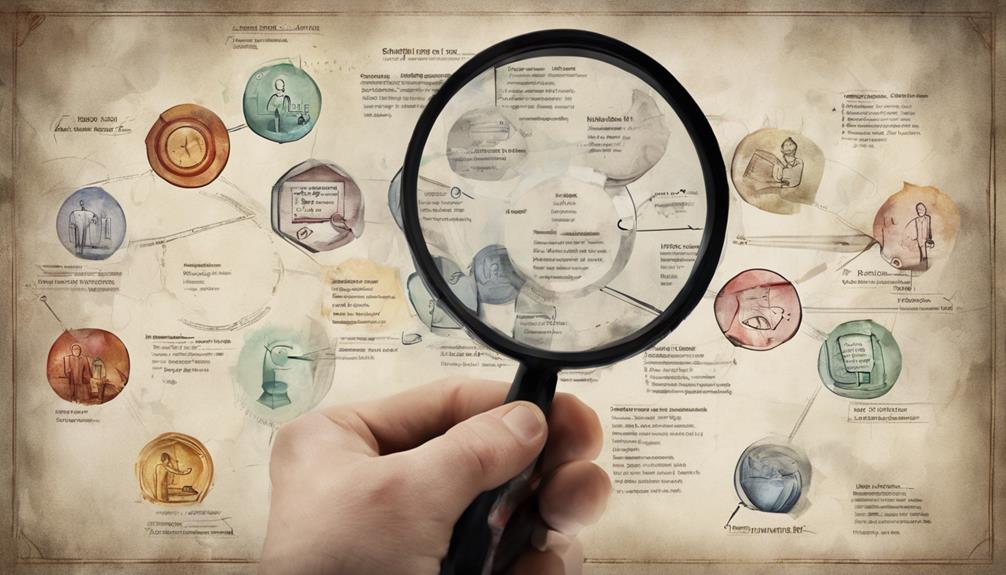Track your goals effectively with proven strategies like SMART criteria for specificity and measurable targets. Set attainable goals with clear deadlines to maintain momentum. Understand the purpose behind your goals for motivation and focus. Create a detailed plan with specific steps and milestones to stay organized. Assess your strengths and weaknesses honestly, collaborating with others for growth. Utilize goal-setting tools like digital apps and traditional planners to enhance accountability. Finding tools that fit your goals and objectives streamlines progress and fosters good habits for success!
Key Takeaways
- Utilize SMART criteria for goal setting.
- Set measurable targets for progress tracking.
- Regularly assess and adjust goals.
- Utilize tools like Trello for organization.
- Reflect on goals' purpose for commitment.
SMART Methodology Criteria

When setting goals, it's vital to adhere to the SMART Methodology criteria for a structured and effective approach. SMART goals refer to objectives that are specific, measurable, attainable, relevant, and time-bound. By following these criteria, you guarantee that your goals are clear, quantifiable, realistic, and have a defined timeline for completion.
One key aspect of SMART goals is their focus on progress tracking. Setting measurable targets allows you to monitor your advancement towards achieving those goals. This tracking not only provides motivation as you see yourself moving closer to your objectives but also enables you to make adjustments if needed to stay on course.
Moreover, SMART goals emphasize the importance of setting realistic objectives. Unrealistic goals often lead to frustration and can hinder progress. By establishing achievable targets that align with your capabilities and resources, you increase the likelihood of success and maintain momentum in your goal pursuit.
How to Set Goals

To establish clear and effective goals, begin by pinpointing specific objectives that outline who, what, where, when, and why you aim to achieve. Setting specific goals involves defining these clear objectives with details on all these aspects.
When setting goals, make sure they're measurable, with tangible benchmarks like Key Performance Indicators (KPIs) for effective assessment. Additionally, confirm your goals are achievable by balancing ambition with realism, aligning them with your capabilities and experience.
It's vital that your goals are relevant, aligning with company objectives to avoid conflicts and focus on benefits. Lastly, make your goals time-bound by setting specific deadlines, ideally within 3 to 12 months. This will help you track your progress effectively and guarantee success in achieving your desired outcomes.
Setting specific, measurable, achievable, relevant, and time-bound goals is crucial for effective goal tracking.
Understand Why

Understanding the root causes for your goals is crucial for maintaining motivation and focus throughout your journey towards achieving them. By regularly evaluating progress, you guarantee that you're on track to meet your personal or professional objectives.
Setting aside dedicated time to assess your goals allows you to realign your efforts toward achieving the desired outcomes. Reflecting on the 'why' behind your goals serves as a constant reminder of the purpose driving your actions, keeping you committed and inspired along the way.
Creating a goal setting template, such as one available on platforms like Trello, can help you clarify and organize your objectives effectively, making it easier to stay focused on what truly matters to you.
Make A Plan

To effectively track your goals, start by creating a detailed plan that outlines specific steps and milestones.
By mapping out your goals in a structured way, you can better monitor your progress and make adjustments as needed.
Remember to check in daily to stay on track and guarantee you're moving closer to your desired outcomes.
Detailed Goal Mapping
Create a roadmap for your goals by engaging in detailed goal mapping, breaking down tasks into manageable steps for better focus and clarity. Through this structured approach, you can set clear objectives and outline the specific actions needed to achieve them.
Visualizing the path to success through detailed goal mapping not only helps in tracking progress but also keeps you motivated along the way.
Utilizing tools such as Trello or daily planners can aid in organizing tasks effectively and monitoring your progress towards your goals. By incorporating these resources into your goal-setting process, you can enhance productivity and guarantee that you stay on track.
Regularly reviewing and adjusting your detailed goal map is essential to maintaining alignment with your overarching objectives and making necessary adaptations to optimize your path to success.
Embrace the power of detailed goal mapping to propel yourself towards achieving your aspirations with confidence and precision.
Daily Progress Monitoring
Regularly reviewing your daily progress towards your goals is essential for staying on track and maximizing productivity. By tracking your progress using tools like a Goal Tracker, you can monitor how well you're advancing towards your objectives. Setting aside time each day to assess your progress allows you to stay focused and make any necessary adjustments to your plan.
Daily goal tracking not only helps you identify obstacles early on but also enables you to address challenges promptly, ensuring continuous progress. Creating a detailed plan and reviewing it daily guarantees that you're making consistent strides towards your goals. This habit of monitoring your daily progress can greatly boost your motivation and drive, keeping you engaged throughout your goal-setting journey.
Recognize Strengths And Weaknesses

When setting goals, it's vital to honestly assess and acknowledge your strengths and weaknesses. Understanding where you excel and where you may need improvement is essential for effective goal setting. By being self-aware of your strengths and weaknesses, you can tailor your goals to align with your capabilities while also identifying areas for growth.
Surrounding yourself with individuals who complement your weaknesses can enhance your chances of achieving your goals. This collaborative approach allows you to leverage the strengths of others to overcome your limitations.
Additionally, continually refining your skills in areas of strength will help you maximize your potential and excel in your goal pursuits.
Set A Goal To Constantly Improve

You should aim to constantly improve in all aspects of your life. Setting goals that focus on continuous growth will push you to work for betterment each day.
Embracing self-improvement strategies is key to unleashing your full potential and achieving your aspirations.
Continuous Self-Improvement Strategies
To consistently enhance your skills and knowledge, setting a goal to continually improve is essential for long-term success.
Here are some strategies to help you achieve continuous self-improvement:
- Embrace the philosophy of continuous growth and self-improvement to achieve lasting success.
- Consume self-help literature and engage with motivational speakers for ongoing learning and development.
- Challenge yourself by setting incremental goals to expand your knowledge, skills, and capabilities over time.
Goal Refinement for Progress
Embracing a mindset of continuous improvement entails constantly refining your goals to drive progress and personal development.
To enhance employee engagement and productivity, it's pivotal to adapt your objectives to evolving circumstances.
Utilizing apps for goal setting can streamline the process, making it easier to track progress on a day-to-day basis.
Self-education and learning from various sources such as self-help books and motivational speakers can provide valuable insights for goal refinement.
Mapping out clear life goals not only offers perspective but also helps you stay focused on what truly matters.
Remember, the key to success lies in pushing yourself to learn more over time and being willing to adjust your goals as needed.
Overview of Goal-Setting Tools

Exploring a variety of goal-setting tools can enhance your ability to track and achieve your objectives more effectively. When it comes to managing tasks and goals, utilizing a project management tool can streamline your progress. Especially during the hustle of New Year's Resolutions, these tools can be invaluable in keeping you on track.
Here are three key points to take into account about goal-setting tools:
- Diverse Range: Goal-setting tools come in various forms, from digital apps like Trello to traditional options like notebooks, offering flexibility to suit your preferences.
- Enhanced Accountability: These tools provide automated reminders, built-in reward systems, and customization features tailored to your habits, boosting your commitment and follow-through.
- Versatile Applications: Whether for personal or team use, these tools cater to different needs, such as mobile apps for individual tracking or collaborative software for group projects.
Goal Setting Tools for Success

Utilize a combination of digital apps and traditional planners to maximize your goal achievement potential. When setting big goals, having the appropriate tools can make all the difference.
Digital apps offer convenience with features like automated reminders and progress tracking, while traditional planners provide a tactile experience that can help reinforce good habits.
For team members working towards a common objective, collaborative goal-setting tools can enhance communication and accountability. These tools allow for shared progress tracking and facilitate group discussions to make sure everyone is aligned and motivated.
Incorporating goal-setting tools that cater to your unique needs and preferences is essential for maintaining momentum and staying on track. Look for apps that offer customization based on your habits and routines, as well as built-in reward structures to keep you motivated.
Consider the cost, compatibility, and functionality of different tools to find the right fit for your specific goals and objectives. By choosing the appropriate goal-setting tools, you can streamline your progress, foster good habits, and ultimately achieve success.
Frequently Asked Questions
How to Track Professional Goals?
To track professional goals effectively, set clear milestones, deadlines, and Key Performance Indicators. Regularly review and update your goals. Seek feedback from mentors or colleagues. Utilize project management software like Asana or Trello for efficient progress tracking.
How to Set Goals Like a Pro?
You set goals like a pro by being specific, measurable, achievable, relevant, and time-bound. Utilize inspiration, purpose understanding, planning, recognizing strengths, and continuous improvement. Choose tools wisely based on cost, compatibility, capabilities, usability, and features.
What Is the Best Strategy for Accomplishing Goals?
To accomplish goals effectively, set SMART objectives, use tracking tools, review and adjust regularly, share goals for accountability, and celebrate milestones. These strategies help you stay focused, motivated, and on track towards success.
What Are the 5 SMART Objectives?
To achieve success, remember the 5 SMART objectives: specific, measurable, achievable, relevant, and time-bound goals. They provide clarity, benchmarks, realism, alignment, and deadlines to keep you focused and on track towards accomplishing your objectives.
Conclusion
To wrap up, by following the SMART methodology criteria, setting clear goals, understanding your why, making a plan, and using goal-setting tools for success, you can track your goals like a pro.
Remember, constantly improve, recognize your strengths and weaknesses, and stay focused on your objectives.
With the right strategies in place, you can achieve anything you set your mind to. Keep pushing forward, keep working towards success, and keep tracking those goals like a pro! Don’t let any setbacks or obstacles deter you from reaching your potential. With determination and perseverance, you can overcome any challenges that come your way. Stay focused on your vision and continue working diligently to achieve your longterm goals. Remember, the journey may be tough, but the reward will be worth it in the end.






